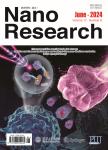The role of aromatic residues in controlling the supramolecular chirality of short amphiphilic peptides
作者机构:Department of Biological and Energy Chemical EngineeringChina University of Petroleum(East China)Qingdao 266580China College of Life ScienceNankai UniversityTianjin 300071China Spallation Neutron Source Science CenterChinese Academy of Sciences(CAS)Dongguan 523803China Institute of High Energy PhysicsChinese Academy of SciencesBeijing 100049China Biological Physics GroupDepartment of Physics and AstronomyThe University of ManchesterManchester M139PLUK School of Material Science and EngineeringChina University of Petroleum(East China)Qingdao 266580China
出 版 物:《Nano Research》 (纳米研究(英文版))
年 卷 期:2023年第16卷第10期
页 面:12230-12237页
核心收录:
学科分类:0808[工学-电气工程] 081704[工学-应用化学] 0809[工学-电子科学与技术(可授工学、理学学位)] 07[理学] 08[工学] 0817[工学-化学工程与技术] 0805[工学-材料科学与工程(可授工学、理学学位)] 070303[理学-有机化学] 0703[理学-化学] 0702[理学-物理学]
基 金:the National Natural Science Foundation of China(Nos.22172193,22072181,and U1832108) a joint Innovate UK-Syngenta funded project under knowledge transfer partnership(No.KTP12697) an EPSRC IAA 377 grant(No.R128362)with Arxada.We acknowledge the use of the resources of the China Spallation Neutron Source in Dongguan of Guangdong Province of China
主 题:amphiphilic short peptide molecular chirality supramolecular handedness aromatic residue π–πstacking
摘 要:Although the relationship between molecular and supramolecular chirality remains elusive,the existing results have demonstrated the vital role of hydrophilic motifs in controlling the supramolecular handedness of peptide nanofibrils compared with hydrophobic ***,unlike conventional hydrophobic residues,we speculate that aromatic hydrophobic residues are mostly likely to play a unique role in regulating the supramolecular handedness because theπ–πstacking interactions of their side chains are directional like hydrogen bonding and can direct high levels of self-assembly due to the geometric confining of aromatic *** confirm this hypothesis,we here design a series of amphiphilic short peptides,with their hydrophobic motifs being composed of aromatic *** short lengths not only favor their structural stability,synthesis,and sequence variation but also enable us to readily link their molecular and supramolecular *** the combination of experiments and theoretical simulations,we demonstrate that the peptides containing L-form aromatic residues form left-handed nanofibrils while those containing D-form aromatic residues assemble into right-handed ones,irrespective of the chirality of their C-terminal hydrophilic *** calculations revealed that the stacking of aromatic side chains betweenβ-strands directed the twisting direction of theβ-sheets formed,with L-and D-form phenylalanine side chains stacking in a clockwise and anti-clockwise way,and more ordered and stronger aromatic stacking for homochiral peptides facilitated the formation of nanofibrils with a marked tubular *** study has bridged the knowledge gap in our understanding of how aromatic residues affect the supramolecular chirality of short peptides.



